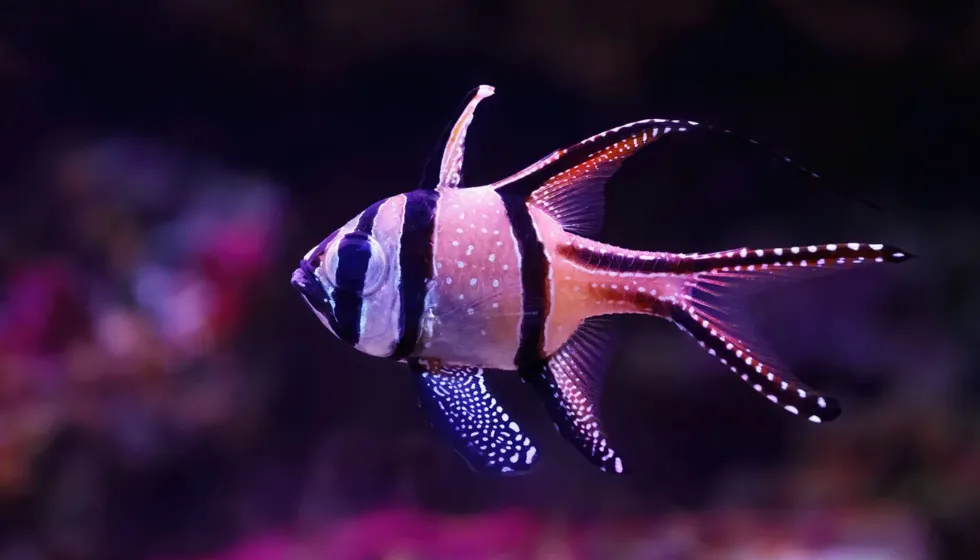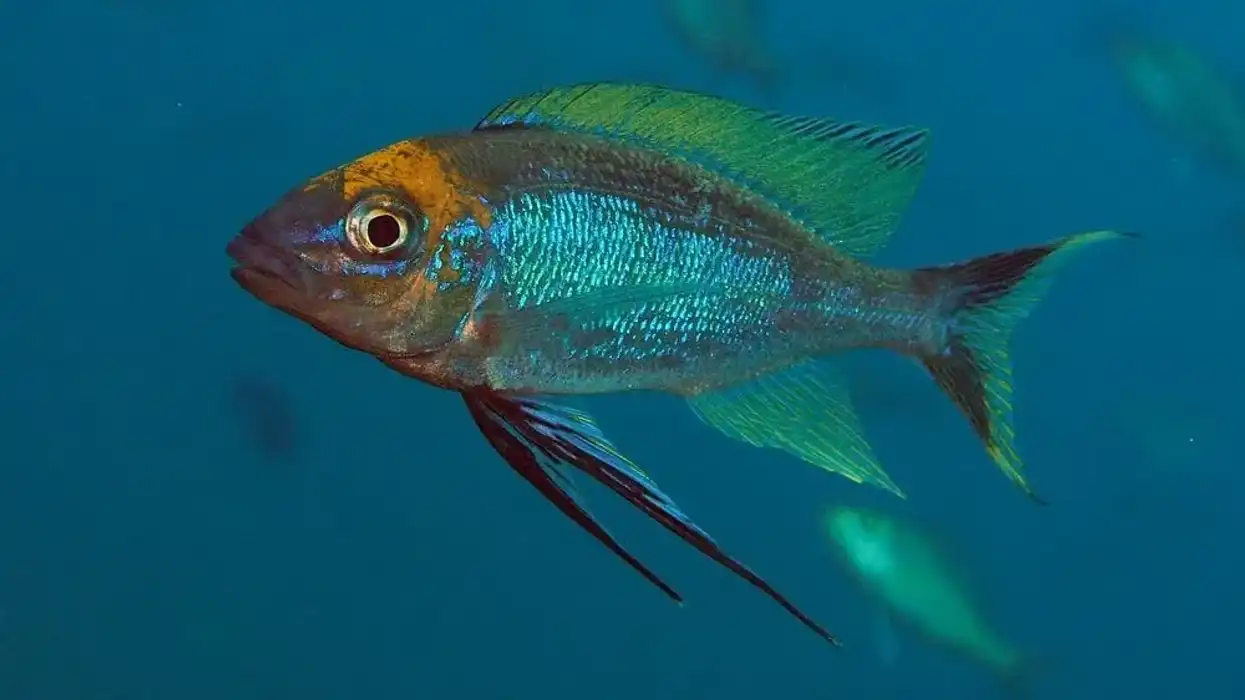The Banggai cardinalfish (Pterapogon kauderni) are a small tropical fish species found in the Banggai islands in Indonesia. They are visually characterized by their silvery body and striking black stripes. They also have a tasseled dorsal fin, a forked caudal fin, and second dorsal fin rays.
Due to the easy nature of their care, they are highly popular with the aquarium trade. This has unfortunately made them an Endangered species, despite a sizeable population of over two million.
They are also considered a critical part of the marine water ecosystem in the Banggai Archipelago. Today, conscious efforts are being made to increase their numbers through captive breeding.
At Kidadl, you can explore sever other fascinating marine species, including the cellophane betta and the leafy seadragon.
Banggai Cardinalfish Interesting Facts
What type of animal is a Banggai cardinalfish?
A Banggai cardinalfish (Pterapogon kauderni) is a small marine animal, just like a goldfish.
What class of animal does a Banggai cardinalfish belong to?
This species belongs to the Actinopterygii class of fish.
How many Banggai cardinalfish are there in the world?
The Banggai cardinalfish (Pterapogon kauderni) has a total population of 2.4 million. Despite this, it is considered an Endangered species due to its small home range of 2,124 sq mi (5,500 sq km) within the Banggai islands of Indonesia.
Where does a Banggai cardinalfish live?
A Banggai cardinalfish lives in large water bodies, like oceans and seas. It can also survive in a captive-bred habitat, like an aquarium or a small water tank.
What is a Banggai cardinalfish's habitat?
In the wild, the Banggai cardinalfish are found in the tropical waters of the Banggai Archipelago, in the Banggai islands of Indonesia. They feed on zooplankton, small, deep-sea fish, and crustaceans.
They also live in small groups of seven to nine fish, close to a coral reef, with long-spined marine animals like sea urchins and coral reef fish. In fact, they depend on these sea animals for protection from predators.
The juveniles in this species are small enough to hide within the spines of these sea creatures, without getting stung.
With this, food and shelter become easily available within a small home range. Hence, they turn into relatively sedentary creatures and have restricted themselves as a species to this small home range.
Due to their popularity with fishers, they are now an Endangered species. Efforts are being made to grow their numbers in a captive habitat such as a small water tank or a large aquarium.
Who do Banggai cardinalfish live with?
They live in small groups of seven to nine in the sea, called a Banggai cardinalfish school. Also, this school has other long-spined marine animals like sea urchins and coral reef fish.
How long does a Banggai cardinalfish live?
This marine species can live between one to two years when it is out in the wild sea. It can live much longer, for four to five years, when it is captive bred in an aquarium or a small water tank.
How do they reproduce?
These species are considered paternal mouth breeders. A female initiates mating in this species. Both genders look similar but may exhibit mild sexual dimorphism during breeding.
A female approaches a male during the breeding season, and courts him with a characteristic 'side by side tremble'. When the male responds positively, they mate. A male is chosen by a female, based on size.
Her first instinct is to choose a similar-sized male. But she can discard him if a bigger male fish shows interest, and replicates the 'side by side tremble'.
Once the pair mate, a female can give birth to a clutch of 60-90 eggs. The female may also leave the school after mating. It is up to the male to care for the young ones.
The male protects the eggs until they hatch, by keeping them in his mouth. This species is hence known as a 'paternal mouth breeder'. Eggs in this species do not go through the larval stage and directly hatch in young fry.
What is their conservation status?
The conservation status of Banggai cardinalfish is Endangered.
Banggai Cardinalfish Fun Facts
What do Banggai cardinalfish look like?
A Banggai cardinalfish is a small fish and can grow up to a length of 2-3 in (6-8 cm). This species is characterized by a bright, silvery body, with white spots.
Each fish has roughly three vertical black stripes along the entire body. It is this striking visual combination that helps distinguish them from other species.
The Banggai also have a tasseled dorsal fin, second dorsal fin rays, and a forked caudal fin near their read end. Male and female fish look similar, except for the mild sexual dimorphism observed during breeding.
How cute are they?
This is a very cute species, with their harmless nature and striking visual appearance. This also makes them popular with fishers and the aquarium trade.
How do they communicate?
Fish mostly use non-verbal cues to communicate. The Banggai fish is especially known for its 'tremble', observed when a female fish courts a male fish.
How big is a Banggai cardinalfish?
A Banggai cardinalfish can grow 2-3 in (6-8 cm) in length. With this, it is half the size of a shrimp.
How fast can a Banggai cardinalfish swim?
The speed of the Banggai cardinalfish is not known. But marine experts believe that small fish can swim much faster than large fish due to their aquadynamic body structure. In fact, the caudal fin in the Banggai cardinalfish is especially useful in achieving higher speeds in water.
How much does a Banggai cardinalfish weigh?
Banggai cardinalfish are very small fish, weighing around 0.4-0.45 oz (11-13 g).
What are their male and female names of the species?
Both genders of Banggai cardinalfish are simply called fish. They also exhibit sexual monomorphism, meaning that they also look similar.
On a side note, do you know that some fish can actually change their gender midway during their lifetime? This is not possible for the Banggai cardinalfish species. But a fish that changes its gender is called a hermaphrodite.
What would you call a baby Banggai cardinalfish?
A baby Banggai cardinalfish is typically called a fry.
Also, a fish goes through multiple life stages as part of its development. In this marine species, the life stages include eggs, fry, juvenile, and adult.
An adult female Banggai fish lays a clutch of eggs after mating with a male. In some fish species, the eggs go through a larval phase before they hatch into fully formed fish bodies. The eggs of a Banggai cardinalfish directly hatch into fry, without going through a larval phase.
It is a young fish before it achieves sexual maturity. It is a fully grown fish that has achieved sexual maturity and can breed.
What do they eat?
This marine species is an omnivore. They feed on plankton, small deep-sea organisms, and small crustaceans like copepods. When they are in a captive-bred habitat, breeders feed them frozen or live animals like brine shrimp, before they are gradually switched to dry fish food.
Banggai cardinalfish are also preyed on by several animal species in the sea, including lionfish.
Are they dangerous?
Banggai cardinalfish are not dangerous to humans. They are small fish that mostly feed on plankton and small crustaceans. They are also adopted by humans as a kind of show pet, captive bred in a small water tank or aquarium. In fact, the aquarium trade is responsible for making this fish an Endangered species.
Would they make a good pet?
Yes, they make great pets as they are pretty fish and not dangerous to humans.
If you wish to adopt them as a pet, here are five interesting facts about Banggai cardinalfish you should know:
It can be housed in a small water tank or aquarium. In fact, this fish can make a striking visual feature, with its silvery body and contrasting black stripes.
It can harmoniously co-exist with most other (non-aggressive) fish species.
It requires a daily feed. This species can also survive without food for a day or two.
It feeds on dry fish food. If your juvenile fish is hesitant to eat this, you can feed it brine shrimp for a few weeks and gradually switch to fish food.
The water in the tank or aquarium needs to be cleaned at least once a month. You can even get away with switching just 50% of the water every alternate month, so the fish still remain in the tank during cleaning.
As you can see, Banggai cardinalfish care is easily manageable. This species is, hence, mighty popular in the aquarium trade!
Did you know...
A male Banggai can survive without food for almost a month! This herculean feat is even necessary during breeding, as it holds its eggs in its mouth during the incubation period.
These fish are reef-safe.
Breeding Banggai cardinalfish
This species is considered a paternal mouth breeder. They are, hence, easily bred in a captive habitat – in a small water tank or a large aquarium – on a steady diet of brine shrimp and dry fish food.
You can begin with a pair, and will soon be inundated with male fish incubating a large number of eggs (up to 90) in their mouth!
Threats to the Banggai cardinalfish
Threat to this species comes in two forms: (over) fishing and disease. In fact, they are considered an Endangered species despite a sizeable population of over two million due to their popularity in the aquarium trade.
Unfortunately, they are also a critical species, needed to maintain the marine ecosystem in the Banggai Archipelago. They are several other marine animals like the lionfish, crocodile fish, krait, and honeycomb grouper, which depend on this species for their food. So environmentalists fear that the potential extinction of the Banggai species will also negatively impact the entire marine ecosystem.
Today, there are conscious efforts made to increase their population numbers through captive breeding. This includes efforts made by the New Jersey State Aquarium, in conjunction with the local governments of Indonesia and Banggai Archipelago.
Here at Kidadl, we have carefully created lots of interesting family-friendly animal facts for everyone to discover! Learn more about some other fish from our queen triggerfish facts and three spot gourami facts pages.
You can even occupy yourself at home by coloring in one of our free printable Banggai cardinalfish coloring pages.










